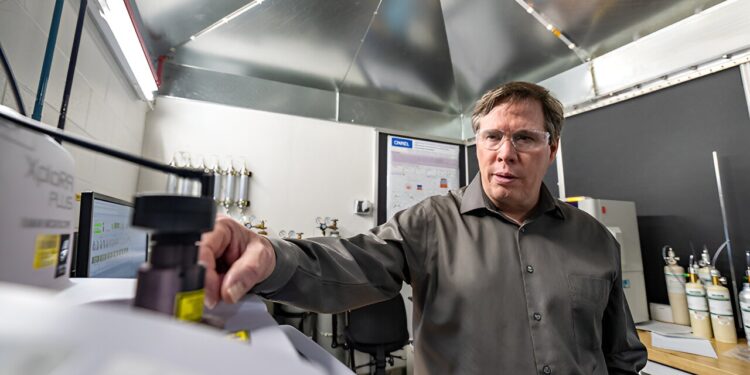NREL’s thermal safety research extends beyond comprehensive characterization to provide accessible approaches to accelerate early battery development. Credit: Werner Slocum, NREL
From current road vehicles to future electrified aircraft, the safety and reliability of energy storage systems are essential for all battery applications. Before entering the market, all battery systems undergo extensive examinations and certifications to confirm that they operate safely under routine and extreme conditions, including fluctuating temperatures, repeated charging and discharging, and full range of driving cycles.
“To ensure battery safety, manufacturers must design battery systems that mitigate risks in worst-case scenarios,” said NREL’s Donal Finegan, principal scientist in NREL’s Electrochemical Energy Storage Group. Catastrophic failure of individual cells is rare, but batteries containing thousands of cells increase the overall risk.
Extreme temperatures from the failure of a single cell can lead to thermal runaway, starting dangerous and toxic fires that spread throughout the battery.
Thermal safety is at the heart of battery research at the National Renewable Energy Laboratory (NREL). Lab scientists provide comprehensive thermal characterization of battery systems, going beyond the industry standard pass/fail certification process to understand what exactly is happening in battery structures before, during and after failure.
As demand for batteries continues to grow, NREL experts are dedicated to developing new approaches to identify potential battery dangers and accelerating national battery safety research.
A study published in Natural communications proposes a new technique for predicting variability in thermal runaway behavior, building on previous NREL research that found correlations between mass ejected from the cell and heat generation.
Traditionally, thermal characterization relies on advanced equipment and capabilities, such as fractional thermal runaway calorimeters, to provide the precise thermal measurements needed to determine heat production during battery failure and efficiently design power packs. safe and lightweight batteries.
However, this equipment is not widely available, making these evaluations both costly and time-consuming and preventing the rapid adoption of new cell types in battery packs.
A more accessible process for early-stage innovations would allow researchers to understand the risks of potential cells and introduce optimized battery designs more quickly, meeting consumer demand for faster charging, increased battery life vehicles and improved lifespan.
“This study offers a simplified solution,” said NREL’s Paul Gasper, co-author of a journal article and senior scientist in NREL’s Electrochemical Energy Storage group. “While there is a wide range of causes of battery failure, our models show the correlation between certain failure characteristics.”
NREL’s most recent research successfully demonstrated how streamlined, inexpensive measurements, such as mass ejected during thermal runaway, could be used to accurately predict the complex thermal behaviors of new cell types that normally require expensive calorimetric measurements.
“Businesses of any size can use this informed approach,” Finegan said. “While we always recommend using a calorimeter for formal safety testing, this approach can help narrow down the safest battery options for your specifications before moving to this stage of research.”
To design this process, the researchers leveraged calorimetric measurements of commercial lithium-ion cells available in the open-access battery failure database created by NREL and NASA.
As the largest public database containing information about cells experiencing thermal runaway, the Battery Failure Databank provided the robust, high-quality data needed to train a machine learning model to identify battery types with predictable failure characteristics.
This new approach will allow energy storage innovators to accurately and quickly estimate the safety risks of new battery designs with minimal expense and effort.
Faster, simpler methods for assessing these thermal characteristics will reinvigorate the battery research community, uniting manufacturers and system designers in our common goal: ensuring the safety of next-generation batteries for applications such as electrified transportation and network-scale storage.
More information:
Karina Masalkovaitė et al, Predicting the heat release variability of Li-ion cells under thermal runaway with little or no calorimetric data, Natural communications (2024). DOI: 10.1038/s41467-024-52653-3
Provided by the National Renewable Energy Laboratory
Quote: New technique streamlines early battery development (October 1, 2024) retrieved October 1, 2024 from
This document is subject to copyright. Except for fair use for private study or research purposes, no part may be reproduced without written permission. The content is provided for informational purposes only.



